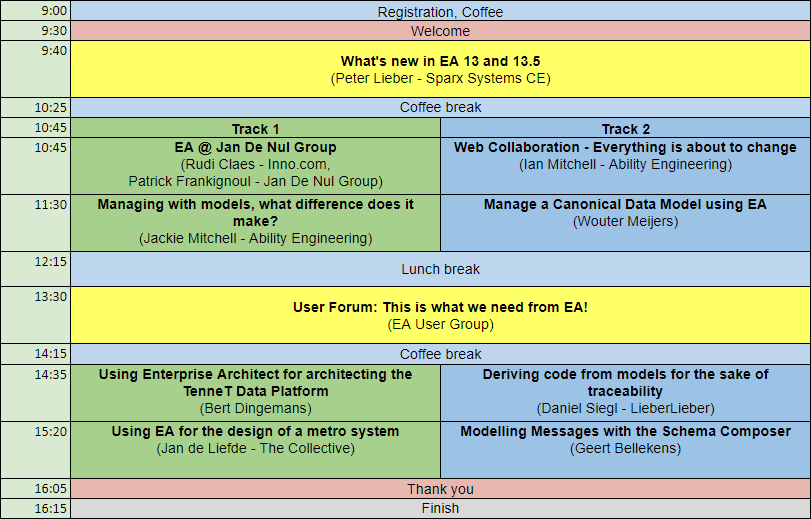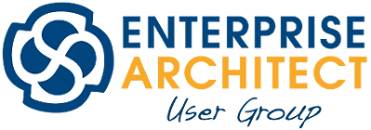
| What’s new in EA 13 and 13.5 | |
| During this session Peter will guide us through the main novelties in the latest versions of Enterprise Architect: versions 13 and 13.5 Find out how Enterprise Architect moves forward and discover which new or improved features can make a difference in your day to day work. | |
| Peter Lieber Sparx Systems CE | |
| Peter Lieber is a Serial Entrepreneur in Software Industry and since September 2014 president of the Austrian Association of Software Industry (www.voesi.or.at). He is committed to sharing knowledge with students, entrepreneurs and managers. In his most relevant businesses: SparxSystems Central Europe (www.sparxsystems.eu/www.sparxsystems.de) and LieberLieber Software (www.lieberlieber.com/www.lieberlieber.us) he is focused on model based systems and software engineering. | |
| EA @ Jan de Nul | |
| The cornerstones of the Jan De Nul Group as a dredging, offshore, civil and environmental contractor are innovation, expertise and sustainability. Thanks to its skilled employees and its continuous investments in own equipment, Jan De Nul Group is a leading expert in the business. The professional and innovative solutions are trusted across the industry. In this session, Patrick and Rudi will explain and demonstrate how JDN is using Enterprise Architect for their Business Process Management project. Business process lifecycle management, improving search ability by a uniform browser-structure and by extended use of custom search, and document generation are important aspects in this project. | |
| Rudi Claes Inno.com Patrick Frankignoul Jan De Nul Group | |
| Rudi is a senior solution architect and enterprise architect, associated with inno.com. Since 2006, he has been implementing, teaching, coaching, and realizing projects with Sparx Enterprise Architect for various organizations in the Benelux. With a specialization and certification in the Microsoft business intelligence (BI) stack since 2008, he has also delivered various BI training courses and realized multiple BI projects. EA4BI combines all his favorite ICT topics –enterprise architecture, modeling, business intelligence and Sparx. Patrick is a senior analyst and project manager with more than 30 years of experience in ICT projects. He was responsible for the total life cycle of software solutions for a wide range of companies, as well packages as custom made solutions. Since two years he is the inspirer of the BPM project at Jan De Nul | |
| Web Collaboration – Everything is about to change | |
| Making EA information available to people via a web interface isn’t just a technical change. It means that knowledge stored in EA can now be shared with whole new groups of business users. Done well, this can massively improve how we engage our stakeholders. Done badly, we’ll just create more confusion. In this talk Ian will explore how this can be a game-changer for us modellers, and show what the future can hold. The future of EA starts here. | |
| Ian Mitchell Ability Engineering | |
| A long-standing EA user, business analyst mentor and teacher, Ian is the author of the popular eaDocX® document generator for EA, as well as being heavily involved with the design of Prolaborate. He also shares his observations from 30+ years in IT at www.theartfulmodeller.com. | |
| Manage a Canonical Data Model using EA | |
| Enexis aims for a flexible and agile integration landscape. The creation of platform-independent service interfaces using a Canonical Data Model (CDM) that is based on open standards (such as OAGIS, HR-XML, UN/CEFACT CCTS and EPRI-CIM), is essential in achieving this goal. However, managing these, mainly large and complex, reference models without proper tooling is no easy task. Enexis has chosen Enterprise Architect as the primary tool for maintenance of the reference models and generation of service interfaces from these models. The presentation will highlight the steps that Enexis has taken to build a CDM management tool using EA and the process we use to transform reference models into a CDM framework, build domain models from the framework, use the Schema Composer to build service profiles and eventually generate service interfaces (both SOAP/XML and Swagger/JSON) from these profiles. | |
| Wouters Meijers Nebulon | |
| Wouter Meijers is a highly experienced technologist with over 30 years of background in information technology, technical automation, multimedia and e-commerce. His focus is mainly on Service Oriented Architecture, Internet technology for portals, application integration and identity & access management. In the past 15 years, he has been working as an Enterprise Architect as well as Solution Architect for various, mostly large, customers in many different business domains, from government to education to industry. Wouter is currently working for Enexis in the role of Data Architect and is responsible for creation, maintenance and roll-out of the EA-based CDM Management tool. | |
| Managing with models, what difference does it make? | |
| In this interactive session, we will investigate how the increasing use of models changes the way that organisations manage their business development, projects and BAU ops. We’ll identify the advantages and disadvantages of working with models, review the options and decisions that need to be made, and understand the likely outcomes of those decisions. The session will include examples taken from: model and project governance risk & issue management contract management reporting ‘Traditional’ Project Lifecycle including change management Agile delivery projects including backlogs, scrums, deployment stakeholder management | |
| Jackie Mitchell Ability Engineering | |
| Jackie has been a project and programme manager, consultant and trainer in technology industries (Aerospace, Health, Telecoms and IT) for more than 30 years. She has taught and delivered projects using a wide range of different PM approaches, tools and methods. Working with Enterprise Architect and a range of clients, Jackie’s recent experience has been helping organisations to integrate structured system design into end-to-end Project delivery, putting EA model data at the heart of their business. | |
| Enterprise Architect as a modelling platform for the integrated design of a metro system | |
| In this presentation, we look at the modelling of a large infrastructure system like a metro system by using Enterprise Architect. We present not only how we made the design by using Use Cases, Functions, Objects and Interfaces but also how we integrated test coverage in relation to release management, Hazard analyses, Geographical deployment, management reporting and specific rail items such as track zones and safe working areas in the design. We will close our presentation with a view on the next steps we are taking to model a network oriented system like a public transportation system. | |
| Jan de Liefde The Collective | |
| Jan de Liefde is co-owner of The Collective and working as a senior consultant for public and private parties. His working field is mostly related to Model Based (Systems) Engineering and Technical Management during the different stages of the System Life Cycle of Infrastructure systems such as tunnels, sluices, water surge barriers and metro. | |
| User Forum: This is what we need from EA! | |
| Enterprise Architect is a tool very diverse tool with numerous features and options to suit everyone. It can be used by project managers, architects, analysts, developers, testers, etc.. But because EA is serving such a diverse user base we feel like sometimes Sparx Systems is not entirely aware of what we as users really need the most from this tool; so let’s do something about that. This session is aimed at gathering a list of top requirements with all EA users present at the meeting. This list will then be presented to Sparx Systems to be considered for implementation. By speaking as a group we can make Sparx Systems understand that these requirements are not just the wishes of an individual user, but the top requirements of the user base in this area. | |
| EA User Group |
| Using Enterprise Architect for architecting the TenneT Data Platform | |
| Many organisations are investigating the possibilities of Big Data solutions, for example the Dutch and German Electricity Transport System Operator TenneT. Introducing Big Data is new and traditional approaches are of limited use. Think about introducing data-lab functionalities, innovative and agile approaches, new technologies like NoSql or Hadoop. How are you going to support these activities in an organisation as an architect and how can Enterprise Architect support you in adding architectural value. In this session we will discuss a reference architecture for the TenneT Data Platforms, modelling techniques, architectural patterns and agile approaches all supported by the use of Enterprise Architect. You will see examples of big data patterns, solutions and templates based on ArchiMate. Participants receive an eap with sample patterns, templates and a sample blueprint of an Big Data Platform. | |
| Bert Dingemans TenneT | |
| Bert is a data architect working often with Enterprise Architect mostly for UML class diagrams and ArchiMate 2.0. He uses Enterprise Architect for generating message documentation, XSD files and modelling enterprise architectures with ArchiMate 2.0 | |
| Deriving code from models for the sake of traceability | |
| The generation of code for embedded targets is becoming more and more common. Especially in light of the EU Directive on data protection, some of the lessons learned are starting to become feasible again for Line of Business Applications. Why? Because it is simply the best way to prove that what you document is also what you run. To be successful with this approach, however, you must prepare yourself. Come and join us to see how EA, with or without third-party tools, can make your software better. | |
| Daniel Siegl LieberLieber | |
| Daniel has been involved with model-based engineering since 2000. He first experienced model-based engineering with Together, and then moved on to the current focus: Enterprise Architect by Sparx Systems. He gained deep experience handling critical software projects around the world in the IT, apparel and footwear industries. The next logical step was to join European-based LieberLieber, the Enterprise Architect Specialists, in 2006. In 2009 he became CEO, and in his role as developer of international business he also became CEO of LieberLieber Software Corp, based in Houston, TX, in 2014.Daniel is heavily involved with LieberLieber’s Automotive and Logistics clients, helping them to build tools to develop their products in a more efficient way. He is passionate about UML/SysML, embedded systems, and industry standards like AUTOSAR. He is an experienced speaker, a founding member of the Enterprise Architect User Group and represents LieberLieber at the Object Management Group. Daniel lives with his family in Vienna, Austria | |
| Modelling Messages with the Schema Composer | |
| Modelling Messages has always been a difficult task in most modelling tools, including Enterprise Architect. Since version 12 EA has a new tool to accommodate this taks: The Schema Composer. With the Schema Composer, you can define messages as a subset of your general information model. You can cherry pick classes, attributes and associations to build the exact message structure you need, without having to duplicate parts of the information model, or resort to somewhat unstable methods such as diagram visibility. In this session Geert wil explain and demonstrate the usage of this powerful tool and its different possibilities for managing your messages in EA. | |
| Geert Bellekens Bellekens IT | |
| Geert Bellekens is an acknowledged Enterprise Architect expert and has written numerous add-ins for Enterprise Architect, including the free open source EA Navigator, EA-Matic etc.. Geert has helped several of the larger Belgian organizations to define and document their modelling method, train and coach the modelers and develop supporting tools for Enterprise Architect. He is also one of the founding members and a regular speaker on the EA User Group events | |
